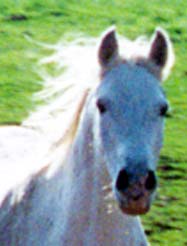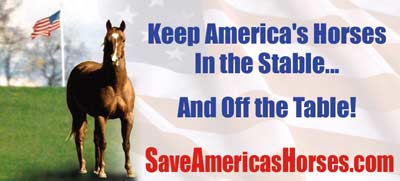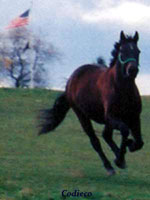
Horse Slaughter
FAQ's
Facts
Slaughter Stats
Public Opinion Polls
Press
What You Can Do!
About
Who We Are
Our Horses
Support/Donations
Merchandise
Contact Us:
Links
California Voters "Just Say Neigh" to Horse Slaughter!
HoofPAC
Equine Protection Network
Shop online at IGive.com with over 400 great stores you know & love- including Back In the Saddle! Up to 26% of the purchase price is donated to the EPN!
Join today!The EPN gets $5 extra the first time you shop!
PayPal accepts credit cards! Please send your tax deductible donation to the:Equine Protection Network, Inc.,
P. O. Box 232, Friedensburg, PA, 17933.
HoofPAC is the political action committee that has been formed to end the slaughter of America's horses. Cathleen Doyle, founder of HoofPAC, led the successful Save The Horses campaign in 1998 that made the slaughter of California's horses a felony.
The EPN thanks the Humane Farming Association for the use of their slaughter video.
Page last revised on:


Frequently Asked Questions on Horse Slaughter
Warning: Photos on this page may be disturbing
What horses are slaughtered?
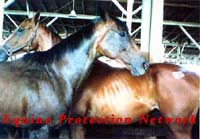 Any horse that falls within the profit margin for slaughter. Horses of all ages and sex are slaughtered including pregnant mares and foals. Former racehorses, show horses, pleasure horses, carriage horses, Amish work and buggy horses, summer riding camp horses, police horses, former therapeutic and handicapped riding horses, lesson horses, rodeo horses, wild mustangs, broodmares, mares used in the production of Premarin and the foals that are the byproduct of the production, and companion horses all been purchased and sent to slaughter.
Any horse that falls within the profit margin for slaughter. Horses of all ages and sex are slaughtered including pregnant mares and foals. Former racehorses, show horses, pleasure horses, carriage horses, Amish work and buggy horses, summer riding camp horses, police horses, former therapeutic and handicapped riding horses, lesson horses, rodeo horses, wild mustangs, broodmares, mares used in the production of Premarin and the foals that are the byproduct of the production, and companion horses all been purchased and sent to slaughter.
Accomplishments won are no guarantee as demonstrated by the slaughter of 1986 Kentucky Derby winner Ferdinand and the Hall of Famer Exceller.
Who slaughters horses and where are they slaughtered?
 Horse slaughterhouses located in the United States are all foreign owned. The horsemeat is federally inspected by the United States Department of Agriculture, (USDA) with your tax dollars footing the bill*. Amendment to the House Agriculture Appropriations Bill on June 8th, 2005 prevents use of public funds. READ UPDATE Under federal law, horses cannot be slaughtered in the same slaughterhouse as cattle, hogs, sheep, or goats.
Horse slaughterhouses located in the United States are all foreign owned. The horsemeat is federally inspected by the United States Department of Agriculture, (USDA) with your tax dollars footing the bill*. Amendment to the House Agriculture Appropriations Bill on June 8th, 2005 prevents use of public funds. READ UPDATE Under federal law, horses cannot be slaughtered in the same slaughterhouse as cattle, hogs, sheep, or goats.
Due to the fact that horses are not raised for food or fiber in this country, and Americans do not consume horses, none of the products that we routinely use on our horses has been approved by the Food and Drug Administration (FDA) for use on horses intended for food. Currently there are three horse slaughterhouses in the United States, two of which are located in Texas. A third slaughterhouse in DeKalb, IL owned by Cavel Int. re-opened on June 7th, 2004 after being rebuilt after a fire destroyed the plant in 2002. In 1999 Cavel had attempted to relocate to Big Foot, IL but was stopped by citizen groups who opposed horse slaughter.
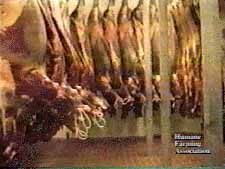 In Texas there is currently a legal battle underway in federal court after the Texas Attorney General's Office issued the opinion that a 1949 Texas law prohibiting the sale and possession of horsemeat did apply to the two Texas slaughterhouses. An effort by Texas Representative Betty Brown to amend Texas law to allow the slaughter of horses for export passed the House, but HB 1324 failed in the Texas Senate after anti slaughter horse organizations hired lobbyists to Kill the Bill, Not Our Horses!
In Texas there is currently a legal battle underway in federal court after the Texas Attorney General's Office issued the opinion that a 1949 Texas law prohibiting the sale and possession of horsemeat did apply to the two Texas slaughterhouses. An effort by Texas Representative Betty Brown to amend Texas law to allow the slaughter of horses for export passed the House, but HB 1324 failed in the Texas Senate after anti slaughter horse organizations hired lobbyists to Kill the Bill, Not Our Horses!
American horses are also exported to Canada and Mexico for slaughter.
Who eats horsemeat?
France, Belgium, Japan, Italy, Switzerland account for the majority of horsemeat consumed in the world.
Are horses slaughtered for pet food?
No. The pet food companies cannot compete with the price paid by the slaughterhouses for human consumption. Slaughter is for human consumption. Horses for human consumption must arrive alive at the slaughterhouse and cannot be killed using any drugs. When pet food companies were required to label the ingredients, the American public voted with their dollars and said neigh to feeding horses to their dogs.
Recent research at Colorado State University, (CSU) is revealing that animals who consume another animal infected with West Nile Virus, (WNV) can contract the disease. Horse meat is not tested for the WNV. The USDA issued a directive in April for meat inspectors to visually inspect horses at the two Texas slaughterhouses for signs of the disease. According to CSU biomedical sciences professor Rich Bowen 9 out of 10 horses infected with the WNV exhibit no signs of illness.
How are horses slaughtered?
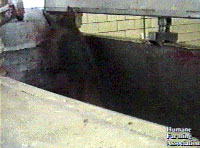 Horses are slaughtered by the use of the captive bolt, a four inch retractable nail. The horses are hit repeatedly in the forehead with the captive bolt which is supposed to render the horse unconscious. One hind leg is then shackled and the horse is lifted into the air upside down to have its throat cut and be bled out. Undercover investigations have shown that horses have been hoisted into the hair while still conscious.
Horses are slaughtered by the use of the captive bolt, a four inch retractable nail. The horses are hit repeatedly in the forehead with the captive bolt which is supposed to render the horse unconscious. One hind leg is then shackled and the horse is lifted into the air upside down to have its throat cut and be bled out. Undercover investigations have shown that horses have been hoisted into the hair while still conscious.
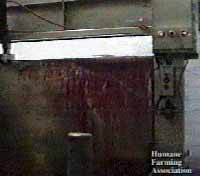 The terrified horses can smell the blood, can hear the horses in front of them being killed and see other horses hanging in the air. Horses shake violently in the knockbox from fear and try desperately to avoid the captive bolt, scrambling and falling on the blood and urine soaked floor of the knockbox.
The terrified horses can smell the blood, can hear the horses in front of them being killed and see other horses hanging in the air. Horses shake violently in the knockbox from fear and try desperately to avoid the captive bolt, scrambling and falling on the blood and urine soaked floor of the knockbox.
How Many Horses Are Slaughtered?
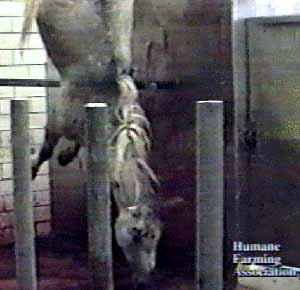 In recent years the number of horses slaughtered has continued to drop since1989 when almost half a million American horses were slaughtered in the United States and Canada. In the late 1980's the tax shelters for horses disappeared and hundreds of thousands of Thoroughbreds, Standardbreds, Quarter Horses and Arabians were dumped onto the market. Killer buyers routinely attended pedigreed horse sales sitting right up front picking up any horse, including stakes winners and full term pregnant mares that sold within the profit margin for slaughter. (Note: Many sales companies specializing in pedigreed horses have now instituted a minimum bid of $1000.00 to prevent horses from being purchased by the killers.)
In recent years the number of horses slaughtered has continued to drop since1989 when almost half a million American horses were slaughtered in the United States and Canada. In the late 1980's the tax shelters for horses disappeared and hundreds of thousands of Thoroughbreds, Standardbreds, Quarter Horses and Arabians were dumped onto the market. Killer buyers routinely attended pedigreed horse sales sitting right up front picking up any horse, including stakes winners and full term pregnant mares that sold within the profit margin for slaughter. (Note: Many sales companies specializing in pedigreed horses have now instituted a minimum bid of $1000.00 to prevent horses from being purchased by the killers.)
According to a story in the Baltimore Evening Sun at the1988 Fasig Tipton sale in Timonium, MD of the 269 Thoroughbreds, 94 sell for less than $600.00. The killer buyer sitting in the front row bought 46, including mares heavy in foal. The reporter finds the horses the next day at the infamous New Holland sale in Lancaster County, PA. The mares are beaten with whips and canes onto double deck cattle trailers and shipped to AmFram in CT. (Am Fram has since closed, as have 12 other horse slaughterhouses).
 Horse slaughter numbers skyrocketed after passage of The Tax Reform Act of 1986 closed the tax-sheltering "passive investment" loophole horse breeders had used to entice wealthy investors interested in a tax shelter bursting the bubble of artificially inflated prices and flooding the market with Arabians, Thoroughbreds, Standardbreds and Quarter Horses. The opening of the floodgates resulted in a bloodbath for the horses as slaughter numbers went from 128,000 in 1985 to 345,500 with another 70,000 horses shipped to Canada in 1990.
Horse slaughter numbers skyrocketed after passage of The Tax Reform Act of 1986 closed the tax-sheltering "passive investment" loophole horse breeders had used to entice wealthy investors interested in a tax shelter bursting the bubble of artificially inflated prices and flooding the market with Arabians, Thoroughbreds, Standardbreds and Quarter Horses. The opening of the floodgates resulted in a bloodbath for the horses as slaughter numbers went from 128,000 in 1985 to 345,500 with another 70,000 horses shipped to Canada in 1990.
After a steady downward trend during the late 1990's, the number of horses slaughtered in 2001 rose to 56,000 due to outbreaks of Foot and Mouth Disease and fears of Mad Cow in Europe. The number dropped to 42,300 in 2002, but a repeat of the late 1980's bloodbath is on the horizon for 2003 after Wyeth Ayerst Laboratories, the manufacturer of the estrogen-replacement drug Premarin® cancelled contracts with a third of all the Pregnant Mare Urine (PMU) farm producers and the remaining producers have been cut in half. According to the North American Equine Ranching Council, (NAERIC) there are 35,000 broodmares on the PMU farms. Various horse welfare organizations put the numbers at 50,000 - 60,000. The PMU farmers are now dumping their broodmares onto the market at the same time as the annual fall auctions of the foals that are a by-product of the industry. There is no way the horse industry and horse welfare organizations can absorb the tens of thousands of drafts and draft cross mares and foals that will flood the market.
In 2005 the numbers are again climbing in part due to the reduction of PMU herds and also due to passage of the infamous Senator Conrad Burns (MT) amendment to the Omnibus Appropriations Bill, (H.R. 4818), signed into law by President Bush on December 7, 2004 repealed the third section of The Wild Free-Roaming Horse and Burro Act of 1971, in which wild horses and burros over the age of 10 years or those that have not been successfully adopted after three adoption attempts could be sold at public auction to the highest bidder, allowing the sale of America's wild horses and burros to be sold to foreign owned slaughter houses. As predicted 41 mustangs were sent to slaughter at Cavel before the BLM put a halt to the sale of anymore mustangs while they reviewed their policy. (See Update)
How do horses end up destined for slaughter?
 Horses are not raised in the United States for food and fiber. When owners breed horses they are dreaming of the next Triple Crown winner or the next National Champion, not their next steak dinner.
Horses are not raised in the United States for food and fiber. When owners breed horses they are dreaming of the next Triple Crown winner or the next National Champion, not their next steak dinner.
The majority of horses destined for slaughter are purchased at non catalogued horse auctions held throughout the United States any day of the week. Owners or dealers bring their horses to these auctions where they may be purchased by agents for the foreign owned horse slaughterhouses. Dealers also answer classified ads in the paper. Very few pleasure horse owners who place an ad to sell their horse would knowingly sell their horse to slaughter. Dealers promise the owner a good home, often telling the owner a time honored story of a good home with green pastures. The dealer makes certain they tell the owner exactly what the owner wants to hear.
 In contrast to the pleasure horse owner, the Amish owner is generally well aware of the final destination of the carriage or work horse that can no longer perform.
In contrast to the pleasure horse owner, the Amish owner is generally well aware of the final destination of the carriage or work horse that can no longer perform.
Lesson horses from riding stables, camp horses from summer camps and even therapeutic riding horses are sent to slaughter. Often the stable owners tell students and boarders that the horse is being retired on a farm by the dealer who is bringing the replacement horse. A trip to the nearest auction is often the real truth.
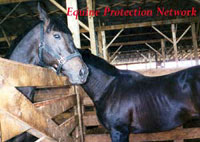 The caretakers of Thoroughbred and Standardbred race horses are well aware of the potential for these horses to be purchased by "killer buyers" and slaughtered for human consumption. The horse's owner though may or may not be aware of the horses' fate. Owners make the decision to sell the horse, sometimes on the recommendation of their trainer. Rarely do they ask where the horse is going. It would be even rarer for the trainer to tell the owner of the possibility that the horse may be purchased by "killer buyers" and sent to a slaughterhouse. If the trainer did inform the owner of this possibility, the owner would be assured that the process was humane.
The caretakers of Thoroughbred and Standardbred race horses are well aware of the potential for these horses to be purchased by "killer buyers" and slaughtered for human consumption. The horse's owner though may or may not be aware of the horses' fate. Owners make the decision to sell the horse, sometimes on the recommendation of their trainer. Rarely do they ask where the horse is going. It would be even rarer for the trainer to tell the owner of the possibility that the horse may be purchased by "killer buyers" and sent to a slaughterhouse. If the trainer did inform the owner of this possibility, the owner would be assured that the process was humane.
What should be done with unwanted horses?
There are horses right now being slaughtered that could be saved if their owners would simply take the responsibility to euthanise their unsound or unwanted horses.
Are there any laws to protect horses?
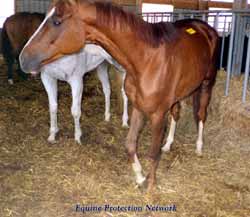 Yes. Pennsylvania has a law that states it is illegal to offer for sale or sell any horse, which by reason of debility, disease or lameness, or for other cause, could not be worked or used without violating the laws against cruelty to animals, or leads, rides, drives or transports any such horse for any purpose, except that of conveying the horse to the nearest available appropriate facility for its humane keeping or destruction or for medical or surgical treatment.
Yes. Pennsylvania has a law that states it is illegal to offer for sale or sell any horse, which by reason of debility, disease or lameness, or for other cause, could not be worked or used without violating the laws against cruelty to animals, or leads, rides, drives or transports any such horse for any purpose, except that of conveying the horse to the nearest available appropriate facility for its humane keeping or destruction or for medical or surgical treatment.
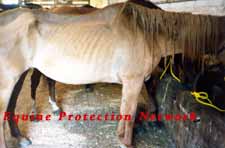 The EPN documented the apparent violations at PA horse auctions for several years and made complaints to local and national animal and horse welfare organizations to no avail. The PA State Police responded to our complaints resulting in an investigation of several auctions, arrests and convictions. The PA State Police investigation resulted in the first successful prosecution of sick, lame and debilitated horses.
The EPN documented the apparent violations at PA horse auctions for several years and made complaints to local and national animal and horse welfare organizations to no avail. The PA State Police responded to our complaints resulting in an investigation of several auctions, arrests and convictions. The PA State Police investigation resulted in the first successful prosecution of sick, lame and debilitated horses.
Several other states have similar laws. The problem is a lack of enforcement and unfamiliarity with the law by law enforcement, failure by citizens to report suspected violations, and unwillingness on the part of some veterinarians to cooperate with law enforcement.
There are horses sold and transported to slaughter every day in this country that are in clear violation of states laws. The enforcement of the laws already on the books in this country could prevent thousands of horses from being sent to slaughter.
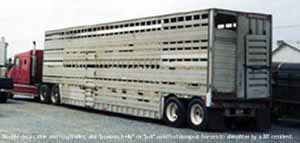 Pennsylvania, (PA) and New York,(NY) have the strongest laws in the United States that ban outright the use of the inhumane double deck cattle trailers to transport any horse no matter what its final destination. PA passed the Horse Transport Law in 2001 under then Governor Tom Ridge while New York's law has been in effect since 1980, with amendments in 1998 and 2002 that closed two loopholes and raised the fines. The EPN brought continued violations of NY law to the attention of the NY State Police, (NYSP) which resulted in several successful prosecutions. The two NY killer buyers that were transporting horses from PA horse auctions using double deckers no longer due so due to the efforts of the EPN and the enforcement by the NYSP and the successful prosecution by the district attorneys in NY.
Pennsylvania, (PA) and New York,(NY) have the strongest laws in the United States that ban outright the use of the inhumane double deck cattle trailers to transport any horse no matter what its final destination. PA passed the Horse Transport Law in 2001 under then Governor Tom Ridge while New York's law has been in effect since 1980, with amendments in 1998 and 2002 that closed two loopholes and raised the fines. The EPN brought continued violations of NY law to the attention of the NY State Police, (NYSP) which resulted in several successful prosecutions. The two NY killer buyers that were transporting horses from PA horse auctions using double deckers no longer due so due to the efforts of the EPN and the enforcement by the NYSP and the successful prosecution by the district attorneys in NY.
Vermont, (VT) and Massachusetts, (MA) also have outright bans of the inhumane double deck trailers for horses. Several other states have legislation regulating the use of double deck trailers to transport horses including, Arizona, California, Connecticut, Minnesota, and Virginia. The regulation allows for the trailers use as long as the trailer meets certain requirements. The result of this regulation is little or no successful prosecution and the continued use of the inhumane trailers.
 The above states laws are effective as demonstrated by the successful prosecution in both PA and NY, after the police were made aware of the violations. Law enforcement depends on the public to report alleged crimes. The public must be on the look out for double deck trailers with horses inside. If you observe a double deck trailer with horses inside in PA, NY, VT, or MA it is illegal and you need to report it to the police.
The above states laws are effective as demonstrated by the successful prosecution in both PA and NY, after the police were made aware of the violations. Law enforcement depends on the public to report alleged crimes. The public must be on the look out for double deck trailers with horses inside. If you observe a double deck trailer with horses inside in PA, NY, VT, or MA it is illegal and you need to report it to the police.
- PA Law is in the Crimes Code, Title 18, Section 5511(e.1)
- NY Law is Ag & Markets Section 359 (a)
- Write down the license plate
- Name on the side of the truck or on the front of the trailer
- Location of truck and direction the truck is heading
- Call the police immediately
- If possible take a picture of the truck, license plate and the horses inside the trailer
- Note the time and date
The infamous Commercial Transportation of Horses to Slaughter Act of 1996 resulted in the legalization of every inhumane practice identified in the transport of horses to slaughter, and put the very people identified as the abusers in charge of the horses! The fox is guarding the hen house, and the final regulations are nothing more than a paper tiger."
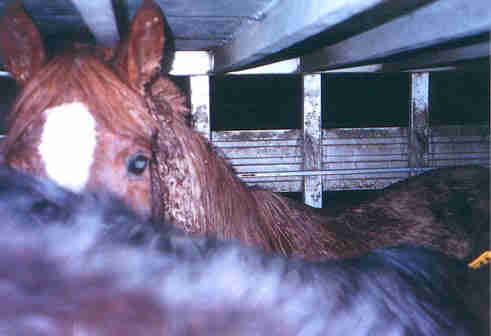 The infamous Commercial Transportation of Horses to Slaughter Act of 1996 was supported both by animal welfare organizations, who were willing to regulate inhumane transport instead of securing an outright prohibition, and by pro-slaughter horse industry organizations intent on slaughtering American horses. The final regulations fly in the face of every accepted horse industry transport method for horses yet at the time, animal welfare organizations claimed it as a victory.
The infamous Commercial Transportation of Horses to Slaughter Act of 1996 was supported both by animal welfare organizations, who were willing to regulate inhumane transport instead of securing an outright prohibition, and by pro-slaughter horse industry organizations intent on slaughtering American horses. The final regulations fly in the face of every accepted horse industry transport method for horses yet at the time, animal welfare organizations claimed it as a victory.
Does the EPN believe that all horses destined for slaughter need to be "saved"?
No. Many horses purchased by "killer buyers" need to be euthanised. The EPN is not opposed to the horse's life ending, we are opposed to:
- the method used to end the horse's life, (slaughter);
- the prolonged suffering of the horse, (transport to a sale, sold, transported to holding facility, and finally transport hundreds or thousands of miles to a slaughterhouse;
- Owners, dealers, auction houses, shippers, and slaughterhouses all profiting from a horse that is suffering due to sickness or injury. The EPN does not believe that irresponsible owners should profit from their irresponsible and sometimes criminal actions.
Save America's Horses! |
|||||||
|
Please send your tax deductible donation to: Equine Protection Network, Inc., P. O. Box 232, Friedensburg, PA, 17933 |
||
Save America's Horses- Make the Commitment to Your Horse! |
||
|
Photos On This Page CANNOT be Used Without Written Permission
|
||

